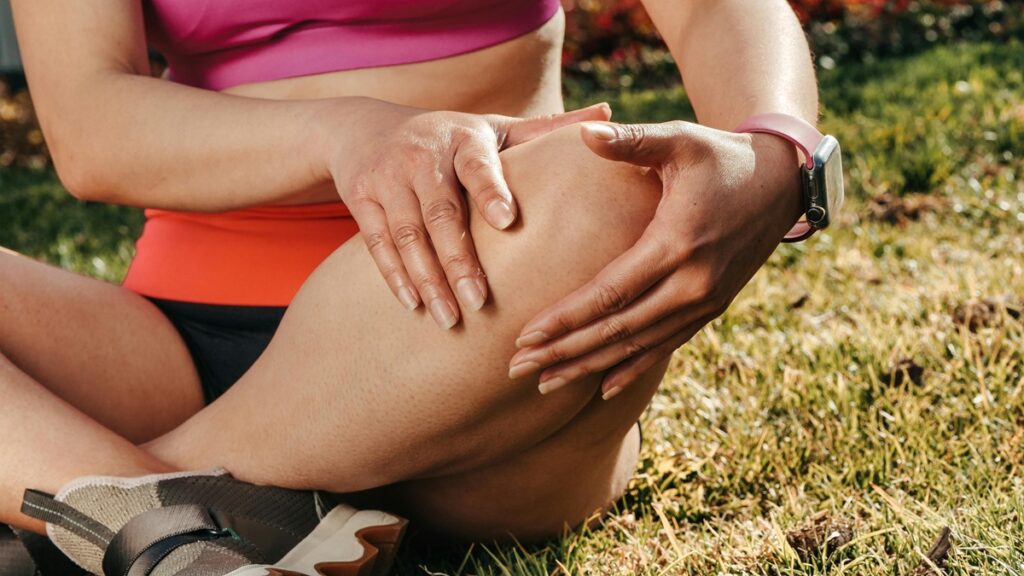
Non-Surgical Blog
Best Exercises for Knee Pain Relief
April 7, 2025

Key Highlights
- Knee pain is a common ailment that can affect people of all ages.
- Gentle stretching and strengthening exercises can help relieve knee pain and improve flexibility.
- It’s crucial to focus on exercises targeting the muscles surrounding the knee, such as the hamstrings, quadriceps, and glutes.
- Low-impact exercises like swimming, walking, and cycling are generally safe for individuals with knee pain.
- Consult with Chattanooga Non-Surgical Orthopedics before starting any new exercise program for personalized guidance.
Experiencing knee pain? You’re not alone. This common ailment can stem from various factors, impacting your mobility and daily activities. Engaging in regular physical therapy, particularly focused exercises, can make a significant difference.
The right exercises can enhance your range of motion, alleviate pain, and help you regain the freedom to move comfortably throughout your day.
Understanding Knee Pain and Its Causes
Knee pain can manifest as a minor annoyance or a debilitating issue, depending on its severity and underlying cause. It’s essential to understand that knee pain is often a symptom of an underlying condition rather than a condition itself. Recognizing the source of your pain is crucial in determining the most effective treatment approach.
Seeking guidance from Chattanooga Non-Surgical Orthopedics is always recommended, especially if the pain is persistent or severe. They can properly diagnose the root cause of your discomfort and recommend an appropriate course of action.
The Anatomy of the Knee
The knee is one of the body’s largest and most complex joints, playing a vital role in movement and weight-bearing activities. To understand knee pain better, it’s helpful to grasp the basic anatomy of this intricate joint.
The knee joint is formed where the thigh bone (femur) and shinbone (tibia) meet. The kneecap (patella), a small, triangular bone, sits in front of the joint for added protection. Strong tendons connect these bones to muscles like the quadriceps and hamstrings, enabling leg extension and flexion.
Ligaments, acting like strong cords, hold the bones together and stabilize the knee joint. Cartilage, a rubbery tissue, cushions the bones and facilitates smooth movement. When any of these components are injured or compromised, it can lead to knee pain.
Common Conditions Leading to Knee Pain
Numerous factors can contribute to knee pain, ranging from acute injuries to chronic conditions. Osteoarthritis, a prevalent form of arthritis, frequently affects the knee joint. It involves the gradual wear and tear of cartilage, causing pain, stiffness, and reduced range of motion.
Injuries such as ligament sprains or meniscus tears can also lead to significant discomfort and impact mobility. While these injuries often result from sudden trauma, they can also develop gradually over time due to repetitive stress.
In some cases, knee pain can arise from tight muscles in the surrounding areas. For instance, tight hamstrings or calf muscles can place added stress on the knee joint, leading to discomfort and restricted movement. It’s essential to address muscle imbalances and maintain flexibility to prevent such issues.
Essential Stretches for Alleviating Knee Pain
Stretching is a vital component of maintaining knee health and relieving pain. Regular stretching helps improve flexibility, reduces muscle tension, and enhances blood flow to the muscles surrounding the knee joint. Incorporating a few key stretches into your routine can make a noticeable difference in your knee’s overall function.
Remember to perform stretches gently and gradually, avoiding any movements that exacerbate your pain. If you experience sharp or intense discomfort while stretching, stop immediately and consult Dr. Hall at Chattanooga Non-Surgical Orthopedics. Listen to your body and prioritize your well-being.
Seated Butterfly Stretch
This simple yet effective stretching exercise targets the inner thighs, which can contribute to knee pain when tight. Regularly practicing the seated butterfly stretch can improve flexibility in the hips and groin, indirectly alleviating stress on the knee joint.
To perform the seated butterfly stretch:
- Sit on the floor with a straight back.
- Bring the soles of your feet together and gently let your knees fall open to the sides.
- Grasp your feet with your hands and gently pull your heels towards your body.
- Maintain good form, keeping your back straight and shoulders relaxed. Hold the stretch for 30 seconds, breathing deeply throughout.
Remember to ease into the stretch gradually, avoiding any forceful movements. You should feel a gentle stretch in your inner thighs, but it should not be painful.
Knee-to-Chest Stretch
This stretch gently targets the muscles surrounding the knee, improving range of motion and reducing tightness. Regular practice can help alleviate pain and improve flexibility in the entire leg.
To perform the knee-to-chest stretch:
- Lie flat on your back on a comfortable surface.
- Bend one knee and gently pull it towards your chest using your hands.
- Ensure your lower back remains flat on the floor throughout the stretch.
- Hold the stretch for 30 seconds, breathing deeply, then release and repeat with the other leg.
This stretch can be modified by pulling both knees towards the chest simultaneously if desired. Pay attention to any sensations in your body and stop immediately if you experience discomfort beyond a gentle stretch.
Core Strengthening Exercises for Knee Support
Strong core muscles play a crucial role in supporting the knees and preventing injuries. A stable core helps maintain proper alignment, reduces stress on the joints, and improves balance, all of which contribute to overall knee health. Incorporating core strengthening exercises into your fitness routine is highly beneficial for individuals with knee pain.
Plank variations, abdominal crunches, and bridges are excellent examples of core strengthening exercises. Remember to perform these exercises with proper form to maximize their effectiveness and minimize the risk of strain or injury.
Bridge Exercise
The Bridge exercise effectively strengthens the glutes and hamstrings, key muscle groups that provide essential support to the knees. By engaging these muscles, the bridge exercise promotes stability and helps alleviate pressure on the knee joints.
To execute the bridge exercise:
- Lie flat on your back with your knees bent and feet flat on the floor.
- Keep your arms at your sides with palms facing down.
- Engage your core and glute muscles as you lift your hips off the floor.
- Your body should form a straight line from your shoulders to your knees.
- Hold this position for a few seconds, then slowly lower your hips back to the starting position.
Perform 2-3 sets of 10 repetitions, focusing on controlled movements and maintaining proper form throughout the exercise.
Pelvic Tilts
Pelvic tilts effectively engage the core muscles, improving stability and reducing strain on the lower back, which indirectly benefits the knees. This gentle exercise helps strengthen the muscles surrounding the spine, promoting better posture and alignment.
Here’s how to perform pelvic tilts:
- Lie on your back with knees bent and feet flat on the floor.
- Maintain a neutral spine, ensuring your lower back is not excessively arched or pressed against the floor.
- Gently tilt your pelvis backward, engaging your core muscles as if you’re trying to draw your belly button towards your spine.
Hold the tilt for a few seconds, then release and repeat for 10-15 repetitions. Focus on maintaining good form throughout the exercise and avoid any jerky movements.
Low-Impact Exercises for Knee Pain Relief
Incorporating low-impact exercises into your routine can help maintain fitness without placing excessive stress on your knees. These types of activities are particularly beneficial for individuals with knee pain as they minimize joint impact while promoting cardiovascular health, muscle strength, and flexibility.
Swimming, water aerobics, cycling, and walking are all excellent low-impact exercises that can be adapted to suit various fitness levels. If you’re unsure which exercises are appropriate for your condition, consult with a physical therapist or healthcare professional.
Swimming and Water Aerobics
Swimming is renowned for being easy on the joints while providing a full-body workout. The buoyancy of water supports body weight, reducing stress on the knees, making it an ideal exercise for individuals with knee pain. Water aerobics offers a similar advantage, providing a low-impact, high-resistance workout that’s gentle on the joints.
Here’s why swimming and water aerobics are great for knee pain:
- Reduced Joint Stress: The buoyancy of water supports your body weight, minimizing stress on your knees.
- Full-Body Workout: Swimming engages multiple muscle groups simultaneously, improving cardiovascular health and strength.
- Gentle Resistance: Water provides resistance, which helps strengthen muscles without the need for weights.
Start slowly and gradually increase the duration and intensity of your workouts. If you’re new to swimming, consider taking lessons from a qualified instructor.
Walking with Proper Footwear
Walking, despite being a simple activity, can significantly improve knee health, when done correctly. It’s a low-impact exercise that helps strengthen the leg muscles, improve joint lubrication, and boost cardiovascular health. However, it’s crucial to wear appropriate footwear that provides adequate cushioning and support.
Here are tips for walking with proper footwear:
- Choose Supportive Shoes: Opt for shoes with good arch support, cushioning in the heel and ball of the foot, and a comfortable fit.
- Start Slowly and Gradually Increase Distance: Begin with shorter walks and gradually increase the distance and duration as your knee strength improves.
- Maintain Good Posture: Walk with a straight back, relaxed shoulders, and engage your core muscles.
- Pay Attention to Your Body: Be mindful of your body’s signals, and don’t push to the point of pain.
Walking on level surfaces is generally recommended, especially for beginners, as it reduces stress on the knees compared to walking uphill or downhill.
Conclusion
If you are looking for relief from knee pain, incorporating these exercises into your routine can make a significant difference. Strengthening and stretching exercises help support your knees and alleviate discomfort. Remember, always listen to your body and consult a healthcare professional before starting any new exercise regimen, especially if you have existing knee issues.
Consistency is key, so aim to stay active and incorporate these exercises regularly to promote knee health and overall well-being. For personalized guidance and support, don’t hesitate to get in touch with our experts at Chattanooga Non-Surgical Orthopedics.
Frequently Asked Questions
Are there exercises I should avoid if I have knee pain?
It’s best to avoid high-impact exercises like running, jumping, or anything that involves deep squats or puts excessive strain on a bent knee. Deep lunges or exercises that target the back of your knee can also aggravate pain, so proceed cautiously.
How often should I exercise to relieve knee pain?
Determining the ideal frequency and number of repetitions for knee pain relief depends on your fitness level and the severity of your condition. It’s a good idea to start slowly. Incorporating exercises into your daily activities is a great start, and building a consistent exercise program is the best way to see results.

Search our blog posts: